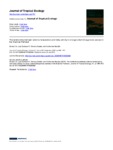Please use this identifier to cite or link to this item:
http://www.alice.cnptia.embrapa.br/alice/handle/doc/1021171Full metadata record
| DC Field | Value | Language |
|---|---|---|
| dc.contributor.author | CID, B. | pt_BR |
| dc.contributor.author | SANTOS, L. G. R. O. | pt_BR |
| dc.contributor.author | MOURAO, G. | pt_BR |
| dc.date.accessioned | 2015-12-05T04:31:34Z | - |
| dc.date.available | 2015-12-05T04:31:34Z | - |
| dc.date.created | 2015-07-31 | pt_BR |
| dc.date.issued | 2015 | pt_BR |
| dc.identifier.citation | Journal of Tropical Ecology, v. 31, n. 5, p. 469-472, 2015. | pt_BR |
| dc.identifier.issn | 0266-4674 | pt_BR |
| dc.identifier.uri | http://www.alice.cnptia.embrapa.br/alice/handle/doc/1021171 | pt_BR |
| dc.description | Daily activity patterns reflect interactions between circadian mechanisms and environmental stimuli. Among these stimuli, temperature can be an important factor affecting activity budgets. To sample the agouti (Dasyprocta azarae), a systematic camera-trap grid was established with 50 independent sampling sites. A circular kernel function was used to characterize the activity patterns of the agouti population. To evaluate shifts in activity as a function of mean daily temperature, the entire set of records was subdivided into smaller sets covering different temperature ranges. The activity pattern belonging to each set was characterized and compared through the overlap of their full activity (95% isopleth) and activity core (50% isopleth). Based on 400 independent records, agoutis were predominately diurnal. They shifted their activity core, while keeping their activity range (the amount of time a population remains active during the 24-h cycle) constant through the temperature gradient. The agouti demonstrated a unimodal activity pattern at lower temperatures,which became more bimodal at higher temperatures. Nevertheless, it kept its activity range constant, regardless of temperature. These results likely reflect a trade-off between activity time and thermoregulation during the diurnal period and demonstrate how the agouti can change its behaviour to achieve thermal comfort. | pt_BR |
| dc.language.iso | eng | eng |
| dc.rights | openAccess | eng |
| dc.subject | Activity | pt_BR |
| dc.subject | Camera-trap | pt_BR |
| dc.subject | Circular kernel | pt_BR |
| dc.title | The relationship between external temperature and daily activity in a large rodent (Dasyprocta azarae) in the Brazilian Pantanal. | pt_BR |
| dc.type | Artigo de periódico | pt_BR |
| dc.date.updated | 2015-12-05T04:31:34Z | pt_BR |
| dc.subject.nalthesaurus | Agouti | pt_BR |
| dc.subject.nalthesaurus | temperature | pt_BR |
| dc.subject.nalthesaurus | rodents | pt_BR |
| riaa.ainfo.id | 1021171 | pt_BR |
| riaa.ainfo.lastupdate | 2015-12-04 | pt_BR |
| dc.contributor.institution | BRUNO CID, UFRJ; LUIZ GUSTAVO RODRIGUES OLIVEIRA SANTOS, UFMS; GUILHERME DE MIRANDA MOURAO, CPAP. | pt_BR |
| Appears in Collections: | Artigo em periódico indexado (CPAP)  | |
Files in This Item:
| File | Description | Size | Format | |
|---|---|---|---|---|
| S0266467415000309a7.pdf | 343.77 kB | Adobe PDF |  View/Open |









